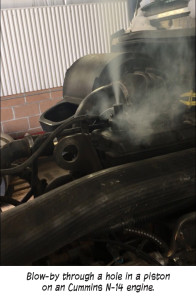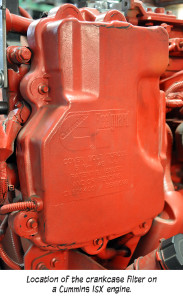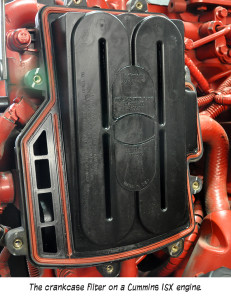Fuel Slobber & More
“Fuel Slobber” happens when diesel engines are started cold, and even worse when the ambient temperature is cold outside, as well. This was a common occurrence back in the 1970s and 1980s, when there was no variable timing on most of the Cummins engines. The 425-B Caterpillar did have advanced timing for cold idling engines, so the fuel slobber wasn’t nearly as bad. The STC-444 Cummins engines also had advanced timing at idle, so they were much cleaner, as well. Many owner operators would see the fuel leaking out of the flex pipe, right behind the turbocharger, and it looked like engine oil, but it’s really fuel and water mixing with the soot in the exhaust system, which looks a lot like oil. This problem would cure itself once the engine came up to the correct operational temperature, which usually didn’t occur until the truck was driven.
With their large cooling systems and the vast amount of air that passes through them during idling, diesel engines tend to run cool. The typical results of burning fuel in a modern diesel engine are about 67% nitrogen, 11% carbon dioxide, 11% water vapor and 9% oxygen. Less than 1% makes up all the “bad” pollutants that diesel exhaust has recently become so infamous for. On a cold start of a diesel engine, the water vapor may be cold enough that it turns into liquid water in the exhaust system – especially on trucks with vertical exhaust stacks. This liquid water can run back down the stack and leak at various clamped joints, making a mess on the chrome elbows, and possibly even leak out of the flex pipe.
This “fuel slobber” problem normally goes away in just a few minutes if the truck is put to work, but if it remains idling, especially on a cold day, the liquid water can be quite a nuisance. Most of us believe that this liquid water is not good for modern diesel particulate filters, especially if the engine is shut down before it gets hot enough to turn the liquid back into a vapor and purge if from the filter. This “slobber” can also run out of the exhaust manifold at the connecting joints and run down the side of the engine. If this happens, just spray the slobber with soap or penetrating oil and wipe it off with a rag (many penetrating oils are also very good cleaning solvents that will also help to keep the engine from rusting).
Blow-by can also create a mess on the engine and the chassis of your truck. The higher the horsepower, and the harder the engine is run, the greater the amount of blow-by the engine will produce. Blow-by is simply compression getting past the piston rings, and all engines have it. Our Oil Trap, which mounts at the bottom of the blow-by tube, is a wonderful item to catch the oil residue which is present in the blow-by gases. This Oil Trap will catch about half a cup of oil every 10,000 miles, and it’s better to be held in a container than spread all over the underside of your truck.
If you want to see the effects of blow-by on the streets, drive a motorcycle down the strip in Las Vegas while it’s raining. When you put your foot on the roadway, it will want to slide out from under you. I can tell you that from personal experience, because trying to hold up an Ultra Classic with a passenger in the back seat is not easy! Many mechanics will tell you the engine is worn out if they see blow-by coming out of the tube, but that is not true – oil consumption is how to measure if an engine is worn out, not blow-by. One gallon of oil consumed every 2,500 miles is considered worn out and, at that point, the engine will need to be rebuilt, but not until then.
Many times, an owner operator will call us and say they had their truck on the dyno and the blow-by was high, so the shop they were at recommended an in-chassis rebuild. We ask what the oil consumption was after an oil and filter change, and oftentimes they say the engine will run 8,000 or more miles before burning the first gallon. If that is the case, the engine is not worn out. Don’t worry about the blow-by, go by oil consumption, to determine when it’s time to rebuild an engine.
I haven’t talked about this for many years, but now that the Big Cam Cummins engines are becoming popular once again, let’s talk about them, and the small 3/8-inch blow-by tube mounted on top of just one of the three valve covers. This may have been sufficient when the NTC350 and 400 horsepower engines were popular, but not anymore – not since we have started increasing the power up to 700 and 800 horsepower. Along with the horsepower increase, the blow-by also increased, so we started installing a breather tube on each of the three valve covers, which solved the problem.
Blow-by must escape out of the engine, and if the blow-by tube is not large enough, the blow-by gases will try to escape up the turbocharger drain tube. The oil coming out of the bearing housing of the turbocharger is in a whipped, foamy state, and it drains via gravity. Keep this in mind: all turbocharger drain tubes must be no more than 30-degrees from vertical, otherwise the oil can be forced past the seals of the compressor wheel and the turbine wheel.
Now, think about this: if blow-by is trying to escape up the turbo drain tube, the turbo oil will not drain down the tube, and instead be forced out of the turbo seals. Because of this, many turbochargers are replaced because of a restriction in the blow-by tube. The newer ISX Cummins engines have a filter prior to the blow-by tube and it must be changed. Never put a piece of heater hose on the bottom of the blow-by tube, as the hot gases will soften the rubber and the wind under the truck will push the hose horizontal and choke off the blow-by gases. Now, a turbocharger is blamed for leaking oil when in fact it’s actually just that piece of hose you put on the blow-by tube.
I write these articles to make you think – I want you to be aware of what is going on under the hood of your truck while you are cruising down the highway, especially when you’re climbing a mountain. We are getting ready to start doing a bi-monthly video on YouTube and on our website, so stay tuned for more about this next month.
Lastly, if you want to send me an e-mail, you will have to call the shop and ask Cathy for my e-mail address, because if I put it in this article, the spammers will bombard me with junk e-mails. Also, always put a subject with your e-mail. I do prefer phone calls to e-mails, it’s just my old-school style of thinking, so consider that when reaching out to me with questions. Please call (724) 360-4080 or visit us online at www.pittsburghpower.com today.





